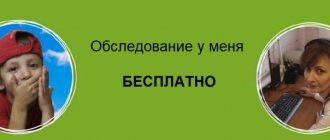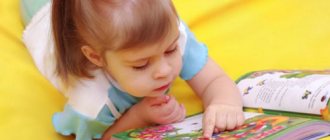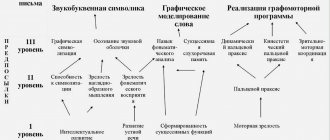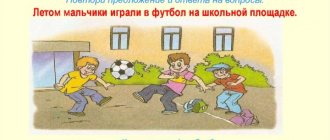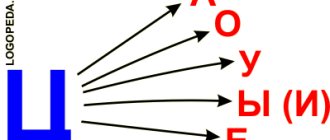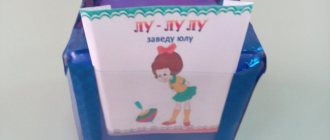Automation of the sound R in sentences combined with TR, DR using mnemonics:
- Grandfather gets off the trolleybus.
- Aunt Tonya is talking with a friend.
- Uncle Trofim is sitting behind a cedar tree.
- Peter has many friends.
- Trams go one after another.
- Three girlfriends are wearing snowflake costumes.
Automation of the sound R in sentences using mnemonics in a combination of consonants TR, DR will help introduce the sound R into coherent speech.
In addition to automating the sound R in sentences on our website, you can find material on automation in syllables, words, phrases, phrases, tongue twisters, stories and poems.
Exercise “Continue the sentence following the example”:
- Katya enters the subway, and Kolya exits the subway.
- Vanya gets on the tram, and Dima...
- Tanya puts away the notebook, and Valya...
- Misha goes to the theater, and Petya...
- Nikolai sells the pipe, and Trofim...
- Masha sits down on the mattress, and Dasha...
- Dima climbs the springboard, and Tolya...
- Vova is digging a trench, and Vanya...
- Olya imitated the trumpet player, and Dima imitated the trumpet player.
- Tanya touched the wall, and Vanya...
- The willow was reflected in the water, and the birch...
- Nastya tore off the sheet, and Petya...
- Yulia was shivering from the cold, and Sasha...
- Dasha kicked her leg, and Misha...
Exercise “Answer questions in complete sentences”:
- Who chops the wood?
- Where does the otter live?
- When do blackbirds fly south?
- How do you get water from a well?
- What do you put the yeast in?
- What can a dragon do?
Summary of an individual lesson on sound automation P in the senior group
Summary of the individual lesson “Automation of the sound R in the sound combinations TR-, DR-“.
Author: Yuliya Viktorovna Yugova, teacher-speech therapist, MADOU “TsRR - kindergarten No. 394”, Perm. Description of the material: I offer you a summary of an individual speech therapy lesson using computer technology to automate the sound R in the sound combinations TR-, DR- for children 5-6 years old.
This material will be useful to practicing speech therapists and parents of children who are consolidating the pronunciation of the sound R. Summary of the individual lesson “Automation of the sound R in the sound combinations TR-, DR-“
Goal: developing the skill of correct pronunciation of the sound [p] in the sound combinations tr-, dr- in the direct unstressed syllable at the beginning of a word. Objectives: Correctional and educational: 1. To form concepts about the sound [p], the mechanism of its formation and the acoustic features of this phoneme 2. To consolidate the correct articulatory image of the sound [p] Corrective and developmental: 1. To develop articulatory motor skills and correct speech breathing 2. To consolidate skill of correct pronunciation of the sound [p] in combinations –tr, -dr isolated, in syllables, in words, in sentences 3. Develop phonemic processes 4. Form a connection between sound and letter 5. Strengthen inflection skills 6. Develop memory, attention and visual perception Correctional and educational: 1. To develop the skill of self-control of speech 2. To cultivate perseverance in class Equipment: mirror, toy mouse; items in the backpack: pen, pencil, book, notebook, pencil case, paints; blue chips, alphabet, threads of different lengths and a sheet of velvet paper, computer, teaching aid - presentation for the lesson. Progress of the lesson 1. Organizational moment, announcement of the topic of the lesson. Today we will have an exciting activity. We will play and learn together with the mouse Valerik. Three trumpeters blew their trumpets.
— What sound do you hear most often in this tongue twister?
- That's right, today we will continue to pronounce the sound [r] beautifully and correctly. 2. Mimic exercises. What good weather today! We will smile at the sun and squint our eyes. We are not afraid of gloomy clouds (furrow our brows) We look without fear. We see a rainbow across the river To everyone’s surprise, (show surprise) We start studying in a good mood! 3. Articulation gymnastics. Slide No. 1 (Pictures are projected on the screen - a window, a cup, a horse, a mushroom, a woodpecker, a magician.) - Let’s show our guest how wonderful we do gymnastics for the tongue: exercises “Window”, “Cup”, “Horse”, “Mushroom” ", "Woodpecker". — Now let’s do the “Focus” breathing exercise. - Very good! 4. Pronunciation of an isolated sound. Slide No. 2 (A moving car and tractor are projected on the screen) - Together with the mouse Valerik, let’s “start the engine.” - A car is driving - TRRRRR
, a tractor is driving -
DRRRRRR
.
5. Analysis of sound articulation. Slide No. 3 (The articulatory profile of the sound [r] is projected on the screen.) - The mouse was unable to immediately “start the engine.” He is surprised - what is the secret? Let's tell Valerik how we pronounce the sound R: - The tip of the tongue rose upward to the tubercles. Spoon-shaped tongue. — Under strong pressure of air, the tip of the tongue trembles at the tubercles. 6. Sound characteristics. - Determine what sound it is. - Consonant
(the tongue creates a barrier to the escape of air).
- Check what sound it is: voiced or dull? Place the back of your hand on the neck and pronounce the sound [r]. - Voiced.
- Is this sound hard or soft?
- Solid.
- What chip do we designate it with?
- A blue chip.
- That's right, the sound [r] is consonant, sonorous, hard.
7. Development of phonemic hearing. — Valerik has things in his backpack. Please determine whether the sound [p] is heard in their names: pen, pencil, book, notebook, pencil case, paints
.
Set aside as many chips as there are objects whose names contain the sound [r]. How to call these items in one word? ( school supplies
).
8. Connection of sound with letter. — The consonant sound [p] is denoted by the letter P, find this letter in the alphabet. How many elements does this letter consist of? Make a letter out of strings. 9. Phys. just a minute. - Look, Valerik is calling us to rest. To quickly relieve fatigue, I will ask you to stand up quietly. Our little mouse stretched, bent over once, bent over twice. Early in the morning I washed my face and dried myself with a towel. He leaned to the right, to the left and came back. He stomped his feet, clapped his hands. Arms to the sides, bend at the elbows and rotate at the shoulders. Hands to the sides, in a fist and on the side. That's the secret of health! Hello to all physical education friends! 10. Automation of sound in syllables. Slide No. 4 (On the screen, cars and tractors of different sizes are projected one after another.) When a large image appears, the child pronounces the syllable loudly. When the image is reduced, the power of the voice decreases. - DRA - dra, tra - TRA
.
11. Automation of sound in words and sentences. Slide No. 5 (Pictures are projected on the screen.) - Name the pictures - bustard, firewood, pipe, trolleybus, tram, grass, jewelry, friends, Buddy
.
- Which of these objects did the mouse Valerik call in other words - tool, bird, animal, transport, decorations, comrades, logs
?
— The name of which objects differs in just one sound? ( bustard - firewood
) - Name the picture based on the action:
pet (Druzhka), invite (friends), play (pipe), chop (wood), give (jewelry), wait (trolleybus, tram), take off (bustard)
.
— Say the humorous phrase “I’m friends with...”
.
- Repeat the sentences: I need another trolleybus.
The woodcutter was carrying firewood along the path. Friends have been working since the morning. The path leads to the dragon .
Slide No. 6 (An image is projected on the screen - trumpeters.) - The mouse suggests learning a tongue twister: Friends blew trumpets
.
12. Gymnastics for the eyes. — Did you like today's lesson? What do you remember? Let's do some eye exercises. We will do eye exercises with you now!
Slide No. 7 (An image of a car moving in a circle is projected on the screen.) Perform circular movements with your eyes.
Slide No. 8 (An image of a moving tractor is projected on the screen.) “Draw” a figure eight with your eyes. Now let’s close our eyes, blink many times, Fun gymnastics will keep our eyes healthy! 13. Summary of the lesson. Well done, today you worked very well, pronounced the sound [r] beautifully and correctly. Valerik enjoyed our lesson. He thanks you. Goodbye! Literature 1. Sedykh N.A.
Education of correct speech in children. – M.: AST, Donetsk: Stalker, 2005. 2. Emelyanova N.V., Zhidkova L.I., Kapitsyna G.A. Correction of sound pronunciation in children 5-6 years old with phonetic speech disorder in the conditions of a speech center at a preschool educational institution. – St. Petersburg: DETSTVO-PRESS, 2013. Presentation on the topic: Automation of the sound R in the sound combinations TR-, DR-
We recommend watching:
Summary of an individual educational activity with a 5-6-year-old pupil for the correction of sound pronunciation. Notes of an educational activity in a senior speech therapy group. Notes of a lesson in a senior speech therapy group. Notes of an individual correctional and developmental speech therapy lesson. Senior group
Similar articles:
Summary of educational activities in the older group of children with severe speech impairments on the topic: “Sounds S - Z”
Summary of educational activities in the senior group of children with severe speech impairments on the topic: “Sounds S - Sh”
Summary of a subgroup GCD to eliminate disturbances in sound pronunciation in children of the older group with severe speech impairments
Summary of educational activities in the senior speech therapy group on the topic “Cossacks and their traditions”
Logorhythmic lesson for children of senior preschool age with special needs on the topic: “What types of transport are there?”
